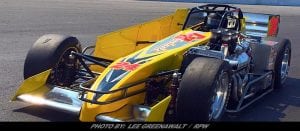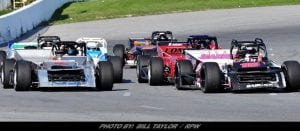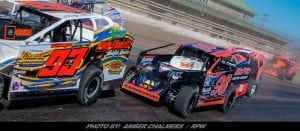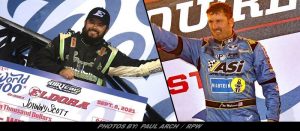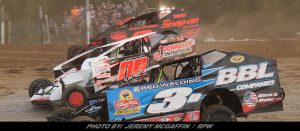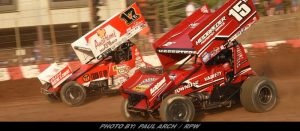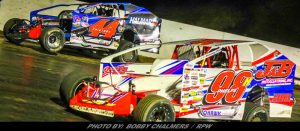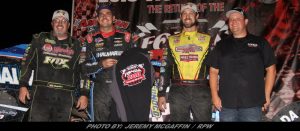Oswego Speedway Remembers Supermodified Icon Fred Graves
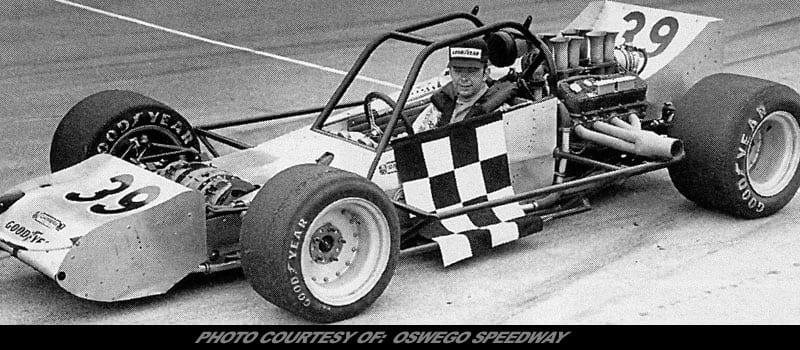

Story By: CAMDEN PROUD / OSWEGO SPEEDWAY – OSWEGO, NY – The Oswego Speedway family has come together in the past 24 hours to remember and honor legendary Supermodified driver, car builder, and owner Fred Graves, who passed away Thursday morning at 71 years old.
“We are saddened to learn of the passing of Fred Graves, one of the all-time great drivers, car owners, and an individual who dedicated much of his life to Oswego Speedway,” said track owner John Torrese. “His legacy will be carried on for many years to come and we extend our warmest thoughts to the Graves family and their friends at this difficult time.”
Graves, a mechanical engineer from Mexico, first made his mark on Oswego back in 1968, wheeling a car built and designed by himself and brother Ron. It didn’t take this new driver very long at all to show success. Graves finished 11th in one of his first events with his family owned No. 92.
After spending his first two seasons behind the wheel of the car he built alongside his brother, Graves returned to the track in 1970 and debuted what would be the Bill Marsh owned red and blue No. 39. Graves wheeled this ride from 1970 through 1972, and drove to his first of nine Oswego victories on July 17, 1971 before returning to victory lane once more with the same car on May 27, 1972.
It was one year after Graves’ second career win that he would do what he is most famous for. Graves set out on a venture to purchase a former Mario Andretti rear engine car. He did so successfully and the Graves team got to work in enough time to debut it during the 1973 season at Oswego with Harry Brandt serving as co-owner. That season, the Graves ride joined some half dozen rear engine cars ready for competition. While he never went to victory lane in ‘73, Graves did manage five top five finishes with the rear-engine ride and then turned to the Rainer No. 29 car for the 200, only to get in another mid-pack skirmish and drop out of the event on lap 185 to finish in the thirteenth position.
Graves returned to the seat in 1974, but in that season he drove several different rides. Midway through the year, the beautiful rear engine car was destroyed in a crash. Fred was then forced to the No. 39 car he drove for Marsh to get back on track while also wheeling the familiar Dick Dunnegan No. 90 in what was one of its final seasons of action at Oswego. It was during that time that he established a relationship with fellow engineer Bill Hite of Alabama, who later would make every other Supermodified obsolete with his four wheel drive creation.
1975 was without a doubt the most prolific season of Graves’ career, as he debuted his new No. 38 roadster on Opening Day of that season. On June 21, he went to victory lane with that car while on the very same night, he revealed one of the most famous Supermodifieds in history; practicing the Hite built rear engine 4WD Supermodified for the first time.
Although Graves and Hite debuted the car on June 21, Freddie did not race it until August 16, this coming after it appeared at the track once more in July as Graves and Hite wanted to ensure they perfected their craft.
Perfect is pretty close to what it turned out to be, as on that second weekend in August, Graves became the first driver in speedway history to win with a front and rear engine car. Fred started 14th and drove to victory in the first ever race for Hite’s masterpiece. Jim Shampine is the only other driver to win with both a front and rear engine in the same season.
A few weeks later, Graves returned with the Hite four wheel drive car for its first shake at the International Classic. Fred was also a car owner for the Classic that year, as fellow rear-engine mastermind Todd Gibson was tabbed as driver of his No. 38 roadster.
In time trials, it was Graves who shattered the track record with an 18.247 to sit on the pole for the 200. Unfortunately though, Fred was also the first car out of the race with gear issues on lap 14, only to be credited with 40th place.
The Hite and Graves combination returned to the Steel Palace for their final season together in 1976 and the success that began with the four wheel drive’s first race a season ago continued in June of 1976 when the first car of its kind in speedway history returned to victory lane once again. Impressively, Graves put the gray No. 39 in the winner’s circle five more times in ‘76 including sweeping the Twin 35s and beating an impressive list of names to do so. 1976 was clearly instrumental in giving Fred his career total (9) victories at Oswego coupled with 31 top five finishes.
After five more wins with the four wheel drive, Graves sat on the pole for the International Classic 200 for the second year in a row in 1976, but this time he broke his own track record, lowering it down to an 18.228. Despite sitting poleside for back to back International Classics, Graves was never able to put the Hite ride in victory lane. Fred battled with rising star Steve Gioia Jr. and defending champ Gary Allbritain in the top three before dropping out with mechanical issues on lap 165.
September 25 of that year was the last time anyone saw the four wheel drive car on the track, as it was banned from competition at Oswego at the conclusion of the 1976 season, but it went out a winner on that same day. This was also Graves final victory at the ‘Big O.’
With Hite’s prized-possession now useless, the rear engine mastermind gave it a shot again and he built Fred another car for 1977. This time, it was a ‘switch’ car, which had both two and four wheel drive. Graves and Hite did not see nearly as much success that season, only able to finish inside the top 15 on one occasion.
In 1978, Fred returned to the speedway with yet another different ride, this time piloting the offset CAM2 Oil 38 car. It was in this ride that Graves joined Shampine as one of only two active drivers to turn laps under 18-seconds. His best finish was only a 12th that season after battling frequent mechanical issues.
Ironically, Graves was back at the track in 1979 as well, this time as a crew chief of the same car he drove last season for another hall of fame driver; Bentley Warren. Warren’s longtime car owner Cindy Snyder fielded that ride for the duration of the season and numbered it 77. Bentley qualified fourth for the Classic with Fred as his chief mechanic.
1980 was Graves last appearance at the track; at least as a driver. In his final race, Fred drove the Shampine / Doug Heveron No. 01 while Heveron drove his newer No. 1 machine. Interestingly enough, Shampine won the race with Heveron finishing in 2nd while Graves finished 17th after a qualifying effort only good enough for mid-pack.
Around that time, the very first ‘Graves Chassis’ debuted, built by Fred and his aforementioned brother Ron. Supermodified campaigner Kevin Lyons got credit for taking one of the first ever Graves racers to the speedway racing surface and by the mid-1980s, business was booming for the Mexico brothers as batches and batches of Graves Chassis were distributed to Oswego and ISMA drivers alike. Many still exist and compete today, and can be credited with dozens upon dozens of Oswego victories.
After successfully building some of the first independent front suspension racers in Oswego history, Fred migrated south and made a name for himself in NASCAR, later going on to win the 1998 NASCAR Craftsman Truck Series Championship as a crew chief for Ron Hornaday. Graves stayed in North Carolina after winning his first NASCAR championship, working in the engineering department for Dale Earnhardt, Inc for a handful of seasons.
In recent years, Graves spent his time living in Vienna, Austria where he worked diligently in vineyards and wineries, very much enjoying his retirement from the sport he gave so much to throughout his versatile career.
With Fred out of the seat, it turned out that both of his brothers would compete in the Supermodified class, with Ron racing alongside him in many of the same events throughout the late 1970s before the duo gave the driving up to become car builders. However, 1980 was not the last time a Graves hit the track at Oswego, as younger brother Cliff also wheeled a Super, of course as No. 38. Cliff first appeared on track in 1988 and nearly won the 1991 Classic but finish third behind Pat Abold and first-time Classic winner Joe Gosek. He retired following the 1993 season with 21 career top five finishes, ten less than Fred had.
Fred’s son Andy is also very active in the sport. Andy won an Indianapolis 500 as team manager in 2001 for Chip Ganassi Racing and driver Juan Pablo Montoya. He’s also worked with Jeff Gordon, won a championship with Terry Labonte in 1996 as assistant crew chief, and spotted for Tony Stewart among many other of NASCAR’s biggest names. Andy worked for Ganassi until 2006, before becoming the Group Vice President and Technical Developer at Toyota Racing Development.
With Graves a key part of the operation, Toyota has recently won its first NASCAR Sprint Cup championship with Kyle Busch, its first NHRA Funny Car championship with Del Worsham, and first Brickyard 400 also with Busch.
Graves’ career in the sport has also included serving as Vice President of Chassis Engineering and Program Manager for NASCAR Sprint Cup, Xfinity, and Camping World Truck Series for two years, during the time in which Toyota earned its first ‘manufacturer’ win in NASCAR. There’s no question that Andy and the rest of Fred’s family will be carrying on the ‘Graves’ name in the sport for many years to come.
Oswego Speedway will have information on Graves’ services when it becomes available. Please stay tuned to OswegoSpeedway.com.


